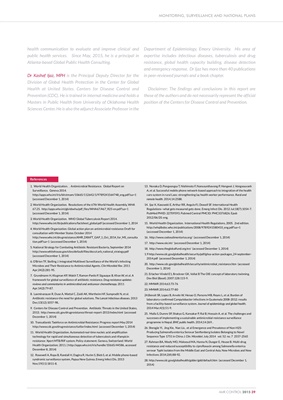
health communication to evaluate and improve clinical and
public health services. Since May, 2015, he is a principal in
Atlanta-based Global Public Health Consulting.
Dr Kashef Ijaz, MPH is the Principal Deputy Director for the
Division of Global Health Protection in the Center for Global
Health at United States. Centers for Disease Control and
Prevention (CDC). He is trained in internal medicine and holds a
Masters in Public Health from University of Oklahoma Health
Sciences Center. He is also the adjunct Associate Professor in the
Department of Epidemiology, Emory University. His area of
expertise includes infectious diseases, tuberculosis and drug
resistance, global health capacity building, disease detection
and emergency response. Dr Ijaz has more than 40 publications
in peer-reviewed journals and a book chapter.
Disclaimer: The findings and conclusions in this report are
those of the authors and do not necessarily represent the official
position of the Centers for Disease Control and Prevention.
MONITORING, SURVEILLANCE AND NATIONAL PLANS
AMR CONTROL 2015 39
References
1. World Health Organization. . Antimicrobial Resistance. Global Report on
Surveillance. Geneva 2014.
http://apps.who.int/iris/bitstream/10665/112642/1/9789241564748_eng.pdf?ua=1
(accessed December 1, 2014)
2. World Health Organization. Resolutions of the 67th World Health Assembly, WHA
67.25. http://apps.who.int/gb/ebwha/pdf_files/wha67/a67_r25-en.pdf?ua=1
(accessed December 1, 2014)
3. World Health Organization. WHO Global Tuberculosis Report 2014.
http://www.who.int/tb/publications/factsheet_global.pdf (accessed December 1, 2014
4. World Health Organization. Global action plan on antimicrobial resistance Draft for
consultation with Member States October 2014
http://www.who.int/drugresistance/amr_draft_gap_1_oct_2014_for_ms_consulta
tion.pdf?ua=1 (accessed December 1, 2014)
5. National Strategy for Combating Antibiotic Resistant Bacteria, September 2014
http://www.whitehouse.gov/sites/default/files/docs/carb_national_strategy.pdf
(accessed December 1, 2014)
6. O'Brien TF, Stelling J. Integrated Multilevel Surveillance of the World's Infecting
Microbes and Their Resistance to Antimicrobial Agents. Clin Microbiol Rev. 2011
Apr;24(2):281-95.
7. Grundmann H, Klugman KP, Walsh T, Ramon-Pardo P, Sigauque B, Khan W, et al. A
framework for global surveillance of antibiotic resistance. Drug resistance updates:
reviews and commentaries in antimicrobial and anticancer chemotherapy. 2011
Apr;14(2):79-87.
8. Laxminarayan R, Duse A, Wattal C, Zaidi AK, Wertheim HF, Sumpradit N, et al.
Antibiotic resistance-the need for global solutions. The Lancet Infectious diseases. 2013
Dec;13(12):1057-98..
9. Centers for Disease Control and Prevention. Antibiotic Threats in the United States,
2013. http://www.cdc.gov/drugresistance/threat-report-2013/index.html (accessed
December 1, 2014)
10. Transatlantic Taskforce on Antimicrobial Resistance: Progress report May 2014
http://www.cdc.gov/drugresistance/tatfar/index.html (accessed December 1, 2014)
11. World Health Organization. Automated real-time nucleic acid amplification
technology for rapid and simultaneous detection of tuberculosis and rifampicin
resistance: Xpert MTB/RIF system. Policy statement. Geneva, Switzerland: World
Health Organization; 2011. ( http://apps.who.int/iris/handle/10665/44586, accessed
December 8, 2014)
12. Rosewell A, Ropa B, Randall H, Dagina R, Hurim S, Bieb S, et al. Mobile phone-based
syndromic surveillance system, Papua New Guinea. Emerg Infect Dis. 2013
Nov;19(11):1811-8.
13. Nonaka D, Pongvongsa T, Nishimoto F, Nansounthavong P, Hongwei J, Vongsouvanh
A, et al. Successful mobile phone network-based approach to integration of the health
care system in rural Laos: strengthening lay health worker performance. Rural and
remote health. 2014;14:2588.
14. Ijaz K, Kasowski E, Arthur RR, Angulo FJ, Dowell SF. International Health
Regulations--what gets measured gets done. Emerg Infect Dis. 2012 Jul;18(7):1054-7.
PubMed PMID: 22709593. Pubmed Central PMCID: PMC3376826. Epub
2012/06/20. eng.
15. World Health Organization. International Health Regulations, 2005. 2nd edition.
http://whqlibdoc.who.int/publications/2008/9789241580410_eng.pdf?ua=1
(accessed December 1, 2014)
16. http://www.codexalimentarius.org/ (accessed December 1, 2014)
17. http://www.oie.int/ (accessed December 1, 2014)
18. http://www.theglobalfund.org/en/ (accessed December 1, 2014)
1.9 http://www.cdc.gov/globalhealth/security/pdf/ghsa-action-packages_24-september2014.pdf
(accessed December 1, 2014)
20. http://www.cdc.gov/globalhealth/security/antimicrobial_resistance.htm (accessed
December 1, 2014)
21. Erlacher-Vindel E1, Brockner GK, Vallat B The OIE concept of laboratory twinning.
Dev Biol (Basel). 2007;128:115-9.
22. MMWR 2014;63:73-76
23. MMWR 2014;63:77-80
24.benoit SR, Lopez B, Arvelo W, Henao O, Parsons MB, Reyes L, et al. Burden of
laboratory-confirmed Campylobacter infections in Guatemala 2008-2012: results
from a facility-based surveillance system. Journal of epidemiology and global health.
2014 Mar;4(1):51-9.
25. Malla S, Dumre SP, Shakya G, Kansakar P, Rai B, Hossain A, et al. The challenges and
successes of implementing a sustainable antimicrobial resistance surveillance
programme in Nepal. BMC public health. 2014;14:269. .
26. Shengjie Yi, Jing Xie, Nan Liu , et al Emergence and Prevalence of Non-H2SProducing
Salmonella enterica Serovar Senftenberg Isolates Belonging to Novel
Sequence Type 1751 in China J. Clin. Microbiol. July 2014 vol. 52 no. 7 2557-2565
27. Rahman BA, Wasfy MO, Maksoud MA, Hanna N, Dueger E, House B. Multi-drug
resistance and reduced susceptibility to ciprofloxacin among Salmonella enterica
serovar Typhi isolates from the Middle East and Central Asia. New Microbes and New
Infections 2014;2(4):88-92.
28. http://www.cdc.gov/globalhealth/gdder/gdd/default.htm (accessed December 1,
2014)